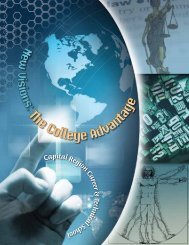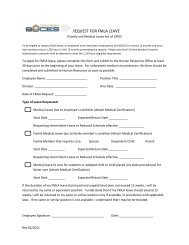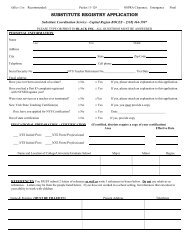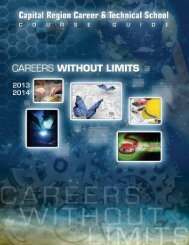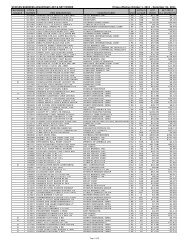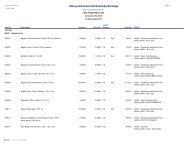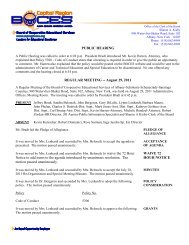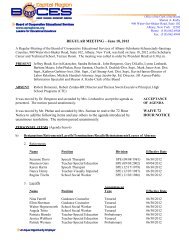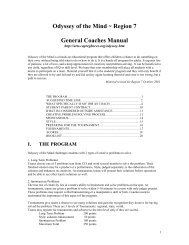Rubrics for Professional Practice - the State Board of Education
Rubrics for Professional Practice - the State Board of Education
Rubrics for Professional Practice - the State Board of Education
Create successful ePaper yourself
Turn your PDF publications into a flip-book with our unique Google optimized e-Paper software.
50 ENHANCING PROFESSIONAL PRACTICE: A FRAMEWORK FOR TEACHING<br />
DOMAIN 1: PLANNING AND PREPARATION<br />
Component 1b: Demonstrating Knowledge <strong>of</strong> Students (continued)<br />
Elements: Knowledge <strong>of</strong> child and adolescent development • Knowledge <strong>of</strong> <strong>the</strong> learning process • Knowledge <strong>of</strong> students’ skills, knowledge, and language pr<strong>of</strong>iciency •<br />
Knowledge <strong>of</strong> students’ interests and cultural heritage • Knowledge <strong>of</strong> students’ special needs<br />
L E V E L O F P E R F O R M A N C E<br />
ELEMENT<br />
UNSATISFACTORY BASIC PROFICIENT DISTINGUISHED<br />
Knowledge <strong>of</strong> <strong>the</strong><br />
learning process<br />
Teacher sees no value in<br />
understanding how students<br />
learn and does not seek such<br />
in<strong>for</strong>mation.<br />
Teacher recognizes <strong>the</strong> value<br />
<strong>of</strong> knowing how students<br />
learn, but this knowledge is<br />
limited or outdated.<br />
Teacher’s knowledge <strong>of</strong> how<br />
students learn is accurate and<br />
current.Teacher applies this<br />
knowledge to <strong>the</strong> class as a<br />
whole and to groups <strong>of</strong><br />
students.<br />
Teacher displays extensive and<br />
subtle understanding <strong>of</strong> how<br />
students learn and applies this<br />
knowledge to individual<br />
students.<br />
Knowledge <strong>of</strong> students’<br />
skills, knowledge, and<br />
language pr<strong>of</strong>iciency<br />
Teacher displays little or no<br />
knowledge <strong>of</strong> students’ skills,<br />
knowledge, and language pr<strong>of</strong>iciency<br />
and does not indicate<br />
that such knowledge is<br />
valuable.<br />
Teacher recognizes <strong>the</strong> value<br />
<strong>of</strong> understanding students’<br />
skills, knowledge, and language<br />
pr<strong>of</strong>iciency but displays this<br />
knowledge only <strong>for</strong> <strong>the</strong> class<br />
as a whole.<br />
Teacher recognizes <strong>the</strong> value<br />
<strong>of</strong> understanding students’<br />
skills, knowledge, and language<br />
pr<strong>of</strong>iciency and displays this<br />
knowledge <strong>for</strong> groups <strong>of</strong><br />
students.<br />
Teacher displays understanding<br />
<strong>of</strong> individual students’ skills,<br />
knowledge, and language pr<strong>of</strong>iciency<br />
and has a strategy <strong>for</strong><br />
maintaining such in<strong>for</strong>mation.<br />
Knowledge <strong>of</strong> students’<br />
interests and cultural<br />
heritage<br />
Teacher displays little or no<br />
knowledge <strong>of</strong> students’ interests<br />
or cultural heritage and<br />
does not indicate that such<br />
knowledge is valuable.<br />
Teacher recognizes <strong>the</strong> value<br />
<strong>of</strong> understanding students’<br />
interests and cultural heritage<br />
but displays this knowledge<br />
only <strong>for</strong> <strong>the</strong> class as a whole.<br />
Teacher recognizes <strong>the</strong> value<br />
<strong>of</strong> understanding students’<br />
interests and cultural heritage<br />
and displays this knowledge<br />
<strong>for</strong> groups <strong>of</strong> students.<br />
Teacher recognizes <strong>the</strong> value<br />
<strong>of</strong> understanding students’<br />
interests and cultural heritage<br />
and displays this knowledge<br />
<strong>for</strong> individual students.<br />
Knowledge <strong>of</strong> students’<br />
special needs<br />
Teacher displays little or no<br />
understanding <strong>of</strong> students’<br />
special learning or medical<br />
needs or why such knowledge<br />
is important.<br />
Teacher displays awareness <strong>of</strong><br />
<strong>the</strong> importance <strong>of</strong> knowing<br />
students’ special learning or<br />
medical needs, but such<br />
knowledge may be incomplete<br />
or inaccurate.<br />
Teacher is aware <strong>of</strong> students’<br />
special learning and medical<br />
needs.<br />
Teacher possesses in<strong>for</strong>mation<br />
about each student’s<br />
learning and medical needs,<br />
collecting such in<strong>for</strong>mation<br />
from a variety <strong>of</strong> sources.<br />
© 2007 by ASCD. All Rights Reserved. 3<br />
No part <strong>of</strong> this work may be reproduced or transmitted in any <strong>for</strong>m or by any means without permission from ASCD.



